On September 11, 2001, when terrorists launched devastating attacks on New York City and Washington, D.C., the U.S. government in turn declared war against terrorism on a global scale, vowing to fight terrorists on both its own and foreign soil. On October 7, 2001, the first large-scale response began—military action against Afghanistan’s Taliban regime and the Al-Qaeda terrorist organization it harbored. The regime fell within a matter of weeks, and by mid-December an interim government had taken its place in Kabul.
In March 2003, the Global War on Terrorism expanded to Iraq in response to Iraqi dictator Saddam Hussein’s refusal to disclose, remove, or destroy his weapons of mass destruction and end all support for terrorist organizations. Shortly before combat operations began, the U.S. Army Corps of Engineers (USACE) participated in the pre-invasion planning by, among other things, helping to prepare a database of Iraq’s transportation, oil, and electrical infrastructure. After the air war began, Corps planners helped prepare target lists and advised coalition forces on targeting decisions. At the outset of the ground war, Corps of Engineers personnel, operating in close coordination with ground forces, helped capture and secure Iraq’s oil fields. In the south the Corps of Engineers’ Task Force Restore Iraqi Oil (TF RIO) and its contractors were instrumental in extinguishing the oil well fires set by the retreating Iraqis. Combat engineers such as the 249th Engineer Battalion participated in the capture of hydroelectric facilities at the Haditha Dam and later helped the dam’s Iraqi staff resume electricity production.
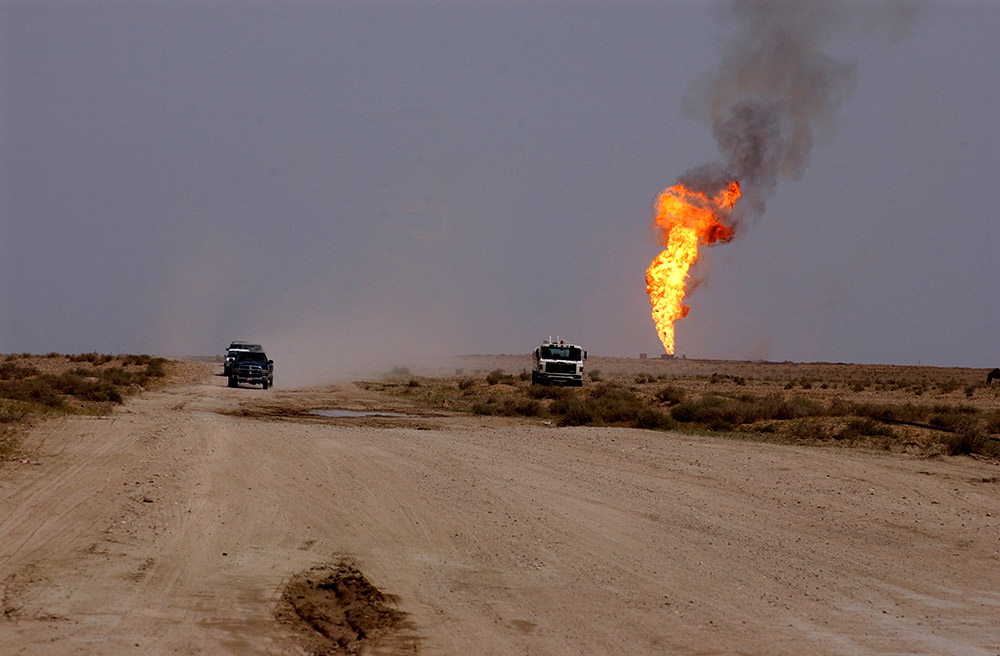 |
|
 |
Oil fire in the Southern Oil Fields near Basrah, Iraq, 10 April 2003.
Office of History, OIF Collection
|
|
Looted electrical panel, Iraq, 4 August 2003.
Office of History, OIF Collection |
Soon after coalition forces toppled the regime of Saddam Hussein, the Corps of Engineers began to address two vital concerns—helping the Iraqis resume the production of oil and repairing some of the nation’s battered electrical infrastructure. To revamp the Iraqi oil infrastructure, TF RIO began to rehabilitate worn or damaged facilities, including oil pipelines, pumping stations, gas-oil separation plants, and refineries. Immediately after combat ceased, when Iraq was neither pumping nor refining oil for domestic consumption, TF RIO also imported hundreds of millions of gallons of benzene and diesel fuel and hundreds of thousands of tons of liquid petroleum gas to sustain the country. In the fall of 2003, the Corps of Engineers established Task Force Restore Iraqi Electricity (TF RIE) to help bolster electrical production and enhance the distribution of power throughout the country. Working closely with their Iraqi counterparts, TF RIE engineers helped refurbish Iraqi power plants, build new generating capacity, rebuild hundreds of miles of electrical transmission lines, construct new electrical substations, and install automated control systems to monitor the flow of power across the nation’s electrical grid.
| |
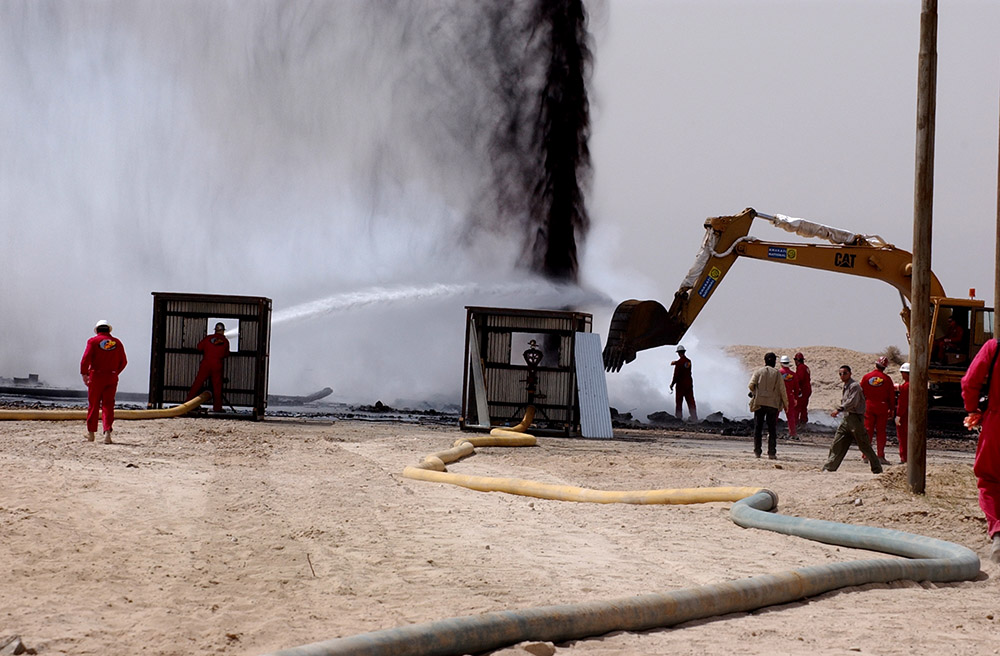 |
|
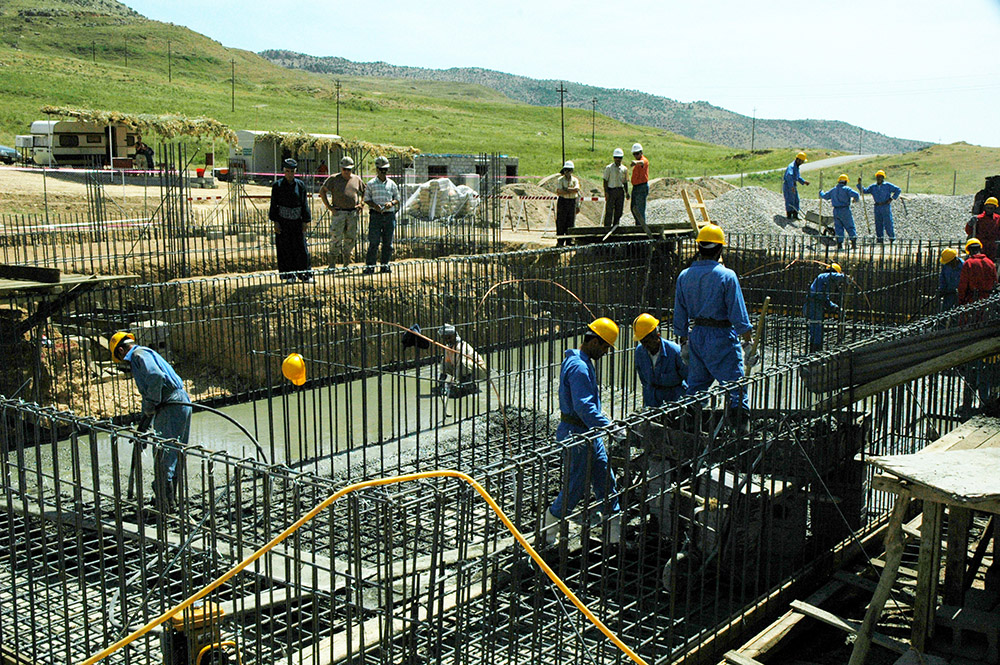 |
| |
Extinguishing an oil well fire in the Southern Oil Fields near Basrah, Iraq, 10 April 2003.
Office of History, OIF Collection |
|
USACE engineers overseeing construction of the foundation of the Dohuk Area Electrical Substation, Dohuk, Iraq, July 2005. Photo by Jim Gordon.
Office of History, OIF Collection |
| |
|
|
|
| |
 |
|
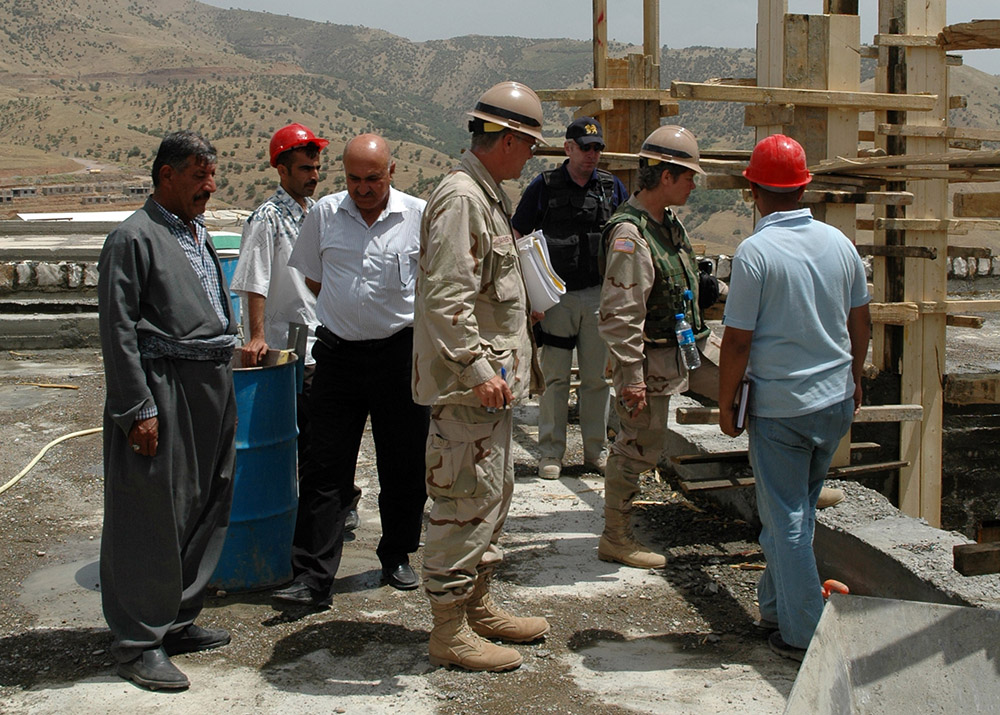 |
| |
Repairs to high-voltage power lines, Iraq,
4 August 2003. Many such towers had been sabotaged or looted.
Office of History, OIF Collection |
|
USACE engineers inspecting the quality of the construction of the Kirkuk Border Fort, Kirkuk, Iraq, May 2005. Photo by Jim Gordon.
Office of History, OIF Collection |
But the rehabilitation of the Iraqi oil and electrical infrastructure was only part of a much larger effort by the American-led coalition to help rebuild Iraq and create a safe, stable, and secure nation. Toward that end, through the Iraq Relief and Reconstruction Fund, the U.S. government allocated approximately $11 billion for 3,000 projects that included the construction or rehabilitation of Iraq’s transportation facilities, water and sewage treatment plants, hospitals and local health clinics, schools, fire and police stations, and border forts.
To provide construction management for the huge undertaking, as well as deliver military construction and maintenance services to the U.S. military in Iraq, in January 2004 the Corps of Engineers established the Gulf Region Division (GRD). Headquartered in Baghdad, the division encompassed three engineer districts, one each in the southern, central, and northern parts of the country. GRD boasted a staff of approximately 500 civilians and 200 military personnel. All the civilians were volunteers, and operations in Iraq marked the first time the Corps of Engineers had sent such a large contingent of civilians into a combat zone.
A few months after GRD’s establishment, hostilities erupted again. This time, rival Shiite and Sunni militias and extremist terrorist groups fought one other and U.S., coalition, and Iraqi troops. Among Shiite militia groups, the Mahdi Army, led by cleric Muqtada al-Ṣadr, was particularly deadly in its battles against others. The guerrilla-style assaults compounded the difficulty of rebuilding Iraq and so, in January 2007, President George W. Bush surged the number of U.S. forces in Iraq by more than 20,000. Although the violence initially was intense, hostilities began to decline toward the end of the year such that some of the additional troops redeployed in 2008. In February 2009, newly elected President Barack Obama announced that the U.S. would withdraw its combat forces from Iraq by August 31, 2010, with the remaining troops due to pull out in December 2011.
As a part of the responsible drawdown of U.S. forces in Iraq, in July 2009 GRD consolidated its North and Central districts into the Gulf Region District. Three months later, USACE inactivated the division, and the newly re-established Transatlantic Division assumed command over the remaining Gulf Region and Gulf Region South Districts. In March 2010, the Corps consolidated its presence in Iraq even further when it converted the Gulf Region South District into an area office under Gulf Region District. The district continued to provide full-spectrum construction management to the United States Forces-Iraq command, the U.S. Embassy-Baghdad Mission, and the Government of Iraq until its inactivation at the end of 2011.
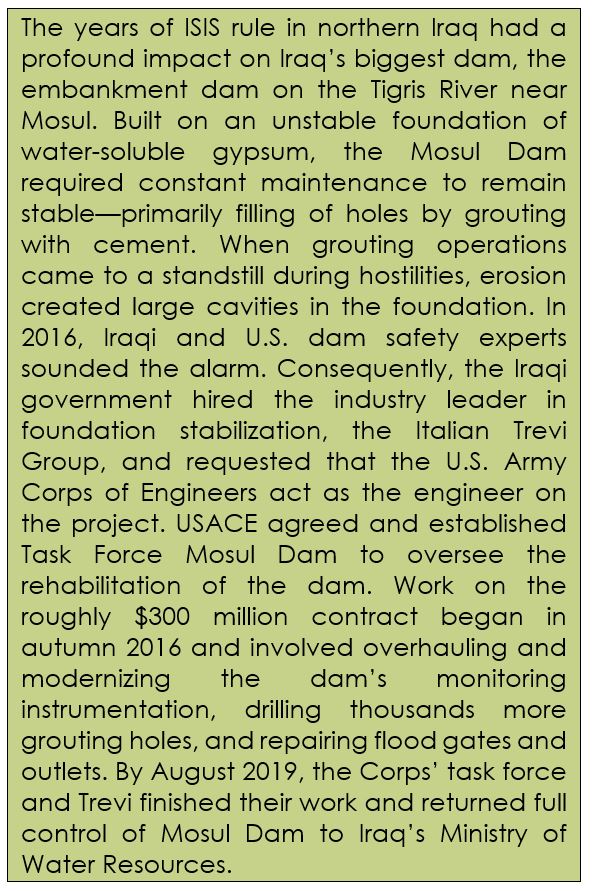 |
|
In the intervening years, the GRD’s engineer soldiers and civilians, undaunted by the dangers posed by the insurgency, helped the Iraqis to add 7,000 megawatts of electricity to Iraq’s power grid and supported the oil industry’s efforts to meet its production capacity of 3 million barrels per day. Five million people benefitted directly from GRD’s water and sewer projects and millions more received treatment in medical facilities the Corps helped build. In addition, the Gulf Region Division managed nearly 1,200 school projects that served hundreds of thousands of children. The division also oversaw construction of hundreds of infrastructure projects such as roads, railroads, aviation facilities, and ports, and it supervised the building of hundreds of vital national security and community safety structures such as border posts, entry facilities, courthouses, and fire stations. In sum, the GRD completed more than 5,100 projects at a construction cost of nearly $9 billion funded by the U.S. government through various programs.
While America withdrew most of its armed forces from Iraq in 2011, the U.S. remained ready to engage if the Iraqi government required support and assistance. Necessity arose within a couple of years when Iraq came under attack from an Al-Qaeda offshoot calling itself Islamic State in Iraq and Syria (ISIS). Unable to withstand the onslaught, Iraqi Security Forces ceded large swaths of territory north and west of Baghdad. By December 2013, ISIS occupied about a third of the country and made Mosul its new capital. In response, the United States assembled a global coalition of 79 countries to defeat ISIS. Operation Inherent Resolve commenced in 2014 and defeated ISIS in three years of, at times, bitter fighting. In 2017, USACE established Task Force Essayons to provide full-spectrum engineering support to the coalition forces’ continuing counter-terrorism mission.
During Operation Iraqi Freedom, the Corps of Engineers supported U.S. and coalition forces during combat and reconstruction and stability operations. In the process, USACE civilians and military established trusting relationships with Iraqi citizens and their government that remained intact even after the U.S. withdrew its forces. For example, the Iraqi government’s request that USACE act as its engineer on the Mosul Dam rehabilitation project was a testament to the Corps’ even-handed professionalism and expertise in construction management.
***
April 2023. No. 161.